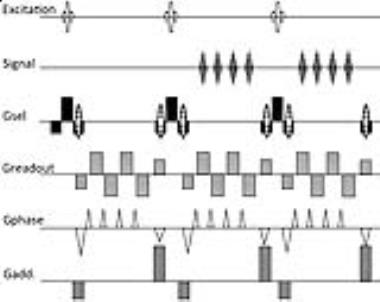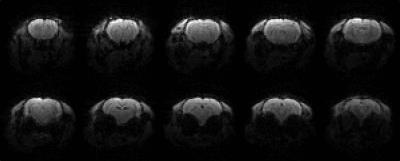5249
PRESTO: an alternative to EPI for functional-MRI in rodents1Institute for Biomedical Engineering, ETH and University Zurich, Zurich, Switzerland, 2Roche Pharma Research & Early Development, Neuroscience Discovery, Roche Innovation Center Basel, F. Hoffmann-La Roche Ltd, Basel, Switzerland, 3Neuroscience Center Zurich, Zurich, Switzerland, 4Institute of Pharmacology and Toxicology, University of Zurich, Zurich, Switzerland
Synopsis
With the increasing need for translational readouts, the number of fMRI studies in rodents has grown exponentially in the recent years. Nonetheless, methodological questions regarding fMRI data acquisition in small animals yet have been poorly addressed. In this work, we evaluate the use of the PRESTO sequence for fMRI in rodents: a 3D alternative to EPI using echo-shifting and echo-trains minimizing distortions and artefacts related to the higher magnetic fields, while providing better brain coverage and faster temporal resolution, allowing appropriate physiological noise sampling.
Introduction
Functional-MRI in small animals has become increasingly popular, in particular with the advent of novel brain stimulation approaches such as optogenetics. As in human fMRI, single-shot EPI has been widely adopted as the readout of choice, even though the method suffers from amplified susceptibility artefacts related to the stronger magnetic fields used in rodents. Because of the higher heart and respiration rates of small animals, the need for faster acquisitions in rodents furthermore has become primordial in order to minimize physiological noise aliasing into the frequency band of interest1. In this work in rats, we have evaluated the performance of PRESTO, a 3D ultrafast gradient echo sequence based on echo shifting and an echo train observation, resulting in whole brain coverage with reduced susceptibility distortions and T2* weighting2,3. We propose a method, which compromises between temporal resolution, geometric distortions, image artefacts and BOLD sensitivity.Material and Methods
The PRESTO sequence was implemented on a BioSpec 9.4T MR system (Bruker BioSpin MRI, Germany) operating under ParaVision 6.0. The sequence diagram for its 3D version can be seen on Fig.1. It was adapted from an EPI method by adding the additional gradients responsible for the echo-shifting on the slice selection gradient. Then the sequences adjustments, timing and its user interface were accordingly adjusted. After initial phantom validation tests, studies were conducted on 6 Lewis rats (female, ~187g) and were carried out by using a volume resonator for transmission and a rat cryogenic phased-array surface coil for reception. Isoflurane (2-3%) mixed with oxygen enriched air was used for inducing and maintaining the animals under anesthesia. Rats were paralyzed via an i.v. injection of pancuronium bromide (Sigma-Aldrich, Germany) and were artificially ventilated while their body temperature was kept constant at 37°C throughout the entire experiment. After acquiring an anatomical reference scan (TR/TE= 1500/6.5ms), animals were electrically stimulated in their right forepaw. Their response was imaged using the 3D-PRESTO sequence in order to evaluate its image quality and BOLD sensitivity (FOV=30x30x10mm3, MD=60x60x20, yielding a voxel dimension of 0.5mm isotropic, flip angle (FA)=4°, TR=10ms, TEeff=15ms, Nseg=8, BW=200kHz, yielding a temporal resolution of 1600ms. The stimulation paradigm consisted of a block design starting with a resting period of 180s followed by three cycles of a 20s stimulus period (2mA, 7Hz) and a 120s post-stimulus period. For analysis of fMRI data, spatial preprocessing of MR data and generation of statistical parametric maps (activity maps) was performed using a custom made script. Statistical parametric maps were generated using the general linear model (GLM). All SNR parametera where extracted by using two ROIs in the somatosensory cortex (left and right) and and four ROIs at the edge of the images to measure noise properties.Results and Discussions
PRESTO allows for high temporal resolution, is more robust to susceptibility distortions (Fig.2) due to its shorter acquisition time, limits inflow effects thanks to its 3D encoding and gives much better coverage as opposed to single-shot EPI. Even if its low efficiency results in lower SNR [SNR = 103+/-44; SNRt = 73+/-16] as compared to conventional EPI4, combined with a phased array cryogenic coil, its sensitivity appears to be sufficient to consistently and reproducibly detect BOLD activations (~4%) related to external stimulations (Fig.3). Because of its time constrains, PRESTO seems to be more adapted for applications requiring a long TE, increasing BOLD sensitivity at the cost of signal losses in lower part of the rodent’s brain as a result of the stronger intravoxel dephasing. As in other multi-shot methods, PRESTO is very sensitive to hardware instability and animal motion. The latest can be yet diminished by appropriate animal preparation using a muscle relaxant and mechanical ventilation.Conclusion
This initial study illustrates the feasibility of using PRESTO for fMRI in rodents, as the method provides good and reliable BOLD sensitivity with super-fast acquisition. Its shorter acquisition window should theoretically lead to lower SNR compared to the standard EPI but this comparison still needs to be performed. In combination with parallel imaging techniques such as SENSE, 3D PRESTO-SENSE5 could provide even higher temporal resolution and more coverage as compared to traditional multi slice imaging.Acknowledgements
We would like to thank Franciszek Hennel and Peter Van Gelderen for the fruitful discussions and inputsReferences
1. Kalthoff D, Seehafer JU, Po C et al. Functional connectivity in the rat at 11.7T: Impact of physiological noise in resting state fMRI, Neuroimage. 2011 Feb 14;54(4):2828-39
2. van Gelderen P, Duyn JH, Ramsey NF et al. The PRESTO technique for fMRI, Neuroimage. 2012 Aug 15;62(2):676-81
3. Gibson A, Peters AM, Bowtell R, Echo-shifted multislice EPI for high-speed fMRI, Magn Reson Imaging. 2006 May;24(4):433-42
4. Hankov G, Kuennecke B, Rudin M et al. Optimizing the parameter space for functional-MRI in rodents ,proceedings of the ISMRM 2016 (program number 2211)
5. Golay X, Pruessmann KP, Weiger M et al. PRESTO-SENSE: an ultrafast whole-brain fMRI technique, Magn Reson Med. 2000 Jun;43(6):779-86
Figures


